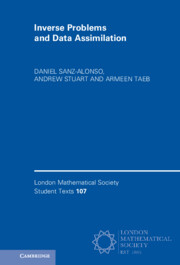Book contents
- Frontmatter
- Dedication
- Contents
- Preface
- Introduction
- Part I Inverse Problems
- 1 Bayesian Inverse Problems andWell-Posedness
- 2 The Linear-Gaussian Setting
- 3 Optimization Perspective
- 4 Gaussian Approximation
- 5 Monte Carlo Sampling and Importance Sampling
- 6 Markov Chain Monte Carlo
- Exercises for Part I
- Part II Data Assimilation
- 7 Filtering and Smoothing Problems and Well-Posedness
- 8 The Kalman Filter and Smoother
- 9 Optimization for Filtering and Smoothing: 3DVAR and 4DVAR
- 10 The Extended and Ensemble Kalman Filters
- 11 Particle Filter
- 12 Optimal Particle Filter
- Exercises for Part II
- Part III Kalman Inversion
- 13 Blending Inverse Problems and Data Assimilation
- References
- Index
Introduction
Published online by Cambridge University Press: 27 July 2023
- Frontmatter
- Dedication
- Contents
- Preface
- Introduction
- Part I Inverse Problems
- 1 Bayesian Inverse Problems andWell-Posedness
- 2 The Linear-Gaussian Setting
- 3 Optimization Perspective
- 4 Gaussian Approximation
- 5 Monte Carlo Sampling and Importance Sampling
- 6 Markov Chain Monte Carlo
- Exercises for Part I
- Part II Data Assimilation
- 7 Filtering and Smoothing Problems and Well-Posedness
- 8 The Kalman Filter and Smoother
- 9 Optimization for Filtering and Smoothing: 3DVAR and 4DVAR
- 10 The Extended and Ensemble Kalman Filters
- 11 Particle Filter
- 12 Optimal Particle Filter
- Exercises for Part II
- Part III Kalman Inversion
- 13 Blending Inverse Problems and Data Assimilation
- References
- Index
Summary
The aim of these notes is to provide a clear and concise mathematical introduction to the subjects of Inverse Problems and Data Assimilation, and their interrelations, together with bibliographic pointers to literature in this area that goes into greater depth. The target audiences are advanced undergraduates and beginning graduate students in the mathematical sciences, together with researchers in the sciences and engineering who are interested in the systematic underpinnings of methodologies widely used in their disciplines.
- Type
- Chapter
- Information
- Inverse Problems and Data Assimilation , pp. xiii - xviPublisher: Cambridge University PressPrint publication year: 2023

